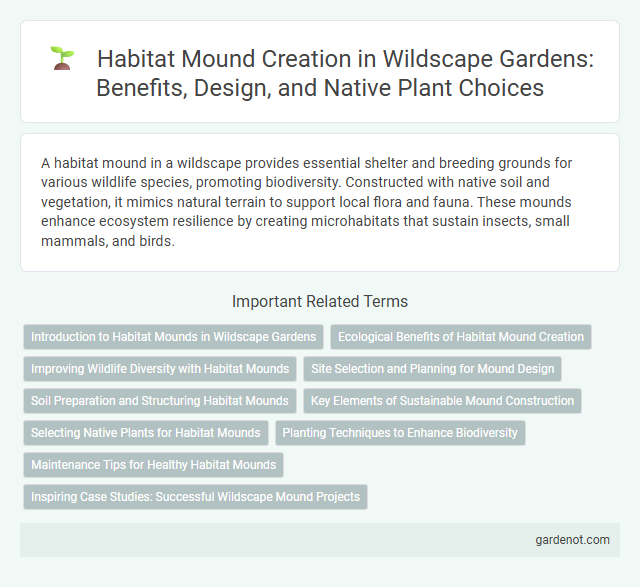A habitat mound in a wildscape provides essential shelter and breeding grounds for various wildlife species, promoting biodiversity. Constructed with native soil and vegetation, it mimics natural terrain to support local flora and fauna. These mounds enhance ecosystem resilience by creating microhabitats that sustain insects, small mammals, and birds.
Introduction to Habitat Mounds in Wildscape Gardens
Habitat mounds in Wildscape Gardens create diverse ecological niches by combining native soil, plants, and microhabitats that support local wildlife. These elevated earth structures mimic natural landscapes, encouraging biodiversity by providing shelter and food sources for insects, birds, and small mammals. By integrating habitat mounds, Wildscape Gardens promotes sustainable conservation practices and enhances urban green spaces with functional, wildlife-friendly environments.
Ecological Benefits of Habitat Mound Creation
Habitat mounds enhance biodiversity by providing elevated, stable environments for native plants and wildlife, mitigating flood risks in wetland areas. Their structure promotes soil stabilization and nutrient cycling, supporting diverse microbial communities essential for ecosystem health. These mounds create microhabitats that increase species richness and resilience against climate extremes, fostering balanced and sustainable wildscapes.
Improving Wildlife Diversity with Habitat Mounds
Habitat mounds create microhabitats that support diverse plant and animal species by offering varied soil conditions, moisture levels, and shelter. These elevated structures promote nesting opportunities for birds, amphibians, and small mammals while enhancing foraging resources for pollinators and ground-dwelling insects. Integrating habitat mounds into Wildscape designs significantly boosts local biodiversity and ecosystem resilience.
Site Selection and Planning for Mound Design
Site selection for a habitat mound in a wildscape prioritizes soil type, drainage capacity, and proximity to native vegetation to support diverse wildlife. Planning involves creating varied elevation zones and incorporating microhabitats to enhance shelter, foraging, and breeding opportunities for target species. Proper orientation and integration with existing landforms reduce erosion and optimize ecological connectivity within the landscape.
Soil Preparation and Structuring Habitat Mounds
Soil preparation for habitat mounds in Wildscape involves loosening compacted soil and integrating organic matter to enhance aeration and nutrient retention. Structuring habitat mounds requires layering diverse soil types to mimic natural gradients, promoting microhabitats for native flora and fauna. Effective mound design supports biodiversity by providing shelter, moisture regulation, and temperature control essential for wildlife sustainability.
Key Elements of Sustainable Mound Construction
Habitat mounds in wildscape design incorporate key elements such as locally sourced natural materials, optimized soil composition for drainage, and native vegetation to support biodiversity. These mounds enhance ecosystem stability by promoting soil erosion control and providing shelter for various wildlife species. Sustainable mound construction also prioritizes minimal environmental disruption and long-term resilience to climate variations.
Selecting Native Plants for Habitat Mounds
Selecting native plants for habitat mounds enhances local biodiversity by providing food, shelter, and breeding grounds for native wildlife species. Native plants are adapted to the local climate and soil conditions, requiring less maintenance and improving soil stability on mounds. Incorporating a diverse mix of native grasses, shrubs, and wildflowers supports pollinators, birds, and small mammals, creating a balanced and resilient ecosystem within the habitat mound.
Planting Techniques to Enhance Biodiversity
Habitat mounds created using diverse native plant species promote structural complexity and support a wide range of wildlife by offering varied microhabitats. Employing techniques such as layered planting with ground covers, shrubs, and trees encourages habitat connectivity and soil health, which boosts insect and bird populations. Incorporating seasonal flowering plants and nitrogen-fixing species enriches soil fertility and sustains pollinators vital for ecosystem resilience in Wildscape areas.
Maintenance Tips for Healthy Habitat Mounds
Regularly aerate habitat mounds to prevent soil compaction and promote root health, ensuring optimal plant growth. Incorporate organic mulch and monitor moisture levels to maintain adequate hydration without waterlogging. Inspect for pests and invasive species frequently, applying eco-friendly treatments to support biodiversity and ecosystem balance.
Inspiring Case Studies: Successful Wildscape Mound Projects
Wildscape habitat mounds effectively restore biodiversity by creating diversified microhabitats that support native flora and fauna, as demonstrated in the successful case study at the Eden Project, where tailored soil compositions promoted rare plant species growth. In the Netherlands, the Oostvaardersplassen mound installation improved bird nesting sites, leading to increased populations of native waterfowl and songbirds. These projects highlight how innovative soil layering and native vegetation integration in wildscape mounds enhance ecological resilience and habitat connectivity.
Habitat mound Infographic

 gardenot.com
gardenot.com